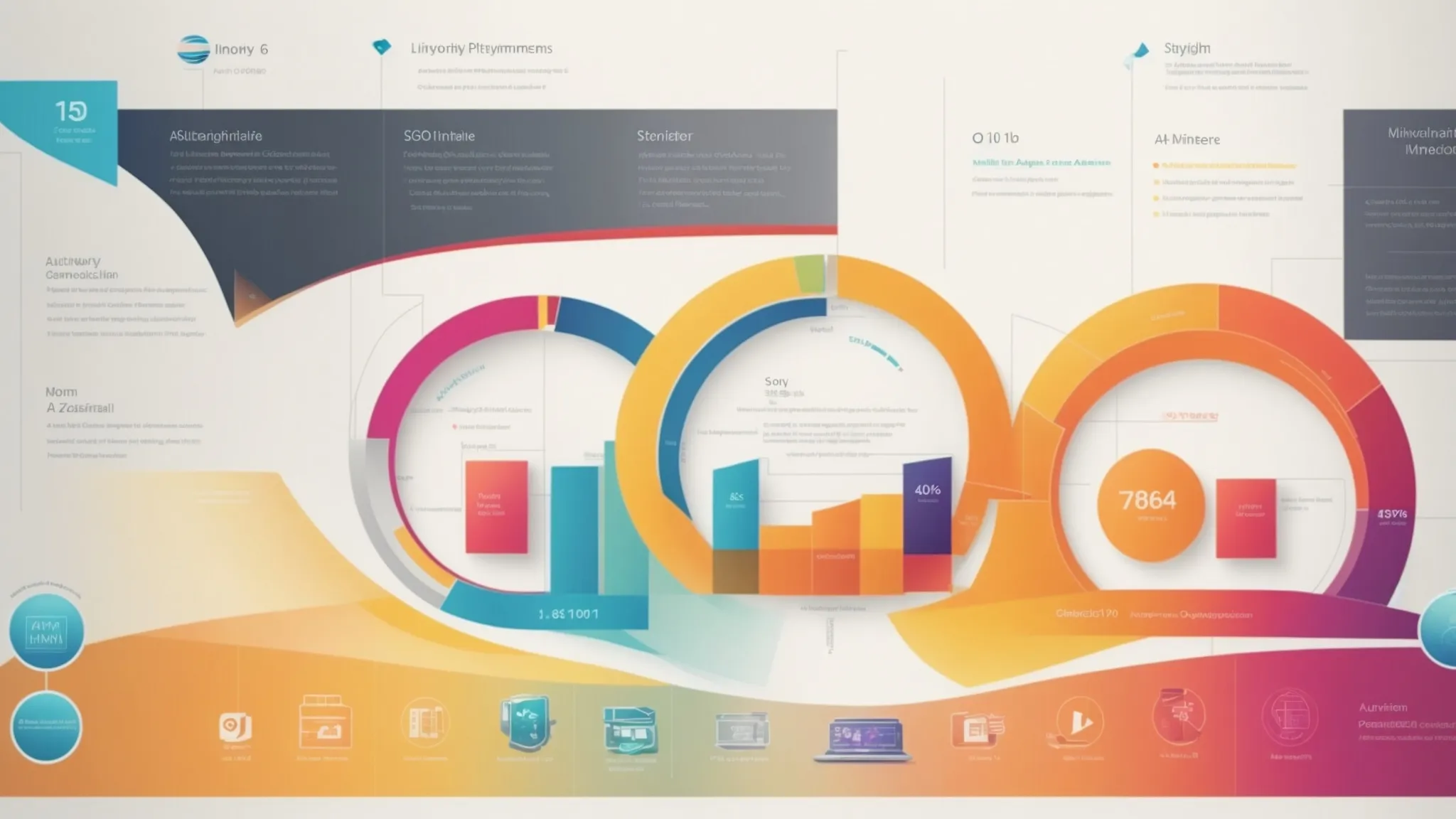Business Process Management (BPM): Definition, Benefits & Tools
Business Process Management (BPM) is essential for organizations seeking efficiency and improved outcomes. Many businesses struggle with streamlined processes, leading to missed opportunities and wasted resources. This article will provide a clear understanding of BPM, highlighting its importance, lifecycle, and various types. Readers will also discover practical examples and the tools that enhance BPM practices. By engaging with this content, business leaders can identify how BPM strengthens their value proposition and boosts overall business value, ultimately solving persistent operational challenges.
What Is Business Process Management?

Business Process Management (BPM) refers to the systematic approach to improving and optimizing an organization’s processes in line with the needs of the digital economy. The key objectives of BPM include enhancing knowledge sharing, ensuring sustainability, and utilizing simulation techniques to streamline operations, such as in accounting. This section will delve into the definition of BPM and its objectives, providing valuable insights into how these elements work together to foster efficiency and effectiveness.
Definition of Business Process Management
Business Process Management (BPM) is defined as a systematic approach that organizations employ to enhance their operational processes for increased efficiency and effectiveness. This encompasses the use of process management software that facilitates the orchestration of various workflows, enabling teams to collaborate seamlessly. By integrating interfaces that promote communication and interaction among different departments, organizations can align their goals and resources more effectively.
The implementation of a robust human resource management system is crucial within the BPM framework, as it helps streamline personnel processes and enhances overall workforce productivity. Organizations that prioritize BPM can significantly reduce operational bottlenecks, ensure optimal resource allocation, and adapt swiftly to changing market demands. Ultimately, BPM serves as a foundation for continuous improvement, driving sustainable growth while addressing the evolving needs of businesses in today’s competitive landscape.
Key Objectives of Business Process Management
The key objectives of Business Process Management (BPM) revolve around enhancing efficiency and fostering automation within organizational workflows. By utilizing business process modeling tools, companies can visualize their processes, identify inefficiencies, and streamline operations. This proactive approach not only leads to improved productivity but also allows businesses to maximize their investment in technology, ensuring that every resource is utilized effectively.
Another crucial objective of BPM is to facilitate adaptability in an ever-changing market. Organizations that implement BPM effectively can respond to shifts in consumer demands or operational challenges more swiftly. For instance, companies employing Linux-based systems often find that their ability to automate routine tasks significantly boosts their operational flexibility, enabling them to maintain a competitive edge while driving continuous improvement across processes.
The Importance of Business Process Management

Business Process Management (BPM) is essential for enhancing efficiency in organizations by streamlining workflows and improving operational performance. A well-implemented bpm system helps achieve higher customer satisfaction through reliable service delivery. Furthermore, it facilitates compliance and risk management, allowing businesses to visualize processes with tools like dashboards and flowcharts, ensuring adherence to regulations and minimizing operational risks.
Enhancing Efficiency in Organizations
Enhancing efficiency within an organization is a primary advantage of Business Process Management (BPM). By establishing clear policies and integrating IT Service Management practices, businesses can optimize their workflows, reducing delays while increasing productivity. For instance, organizations that strategically outsource non-core functions often find that BPM frameworks help align these outsourced processes with their overall objectives, thus fostering a more cohesive operational model.
The application of Total Quality Management principles further amplifies the efficacy of BPM initiatives. By creating a culture that emphasizes quality at every stage, organizations can streamline operations and improve service delivery. This focus on quality ensures that all processes are continuously evaluated and improved, ultimately leading to heightened customer satisfaction and a robust competitive position in the market.
Improving Customer Satisfaction
Improving customer satisfaction is a vital objective of Business Process Management (BPM), as it directly influences a company’s success in the marketplace. Utilizing tools such as process workflow software enables organizations to streamline interactions, thereby reducing response times and enhancing service quality. A business rules engine can also facilitate consistent decision-making, ensuring that customer inquiries are handled promptly and accurately, which fosters loyalty and trust.
Furthermore, integrating business intelligence into BPM allows organizations to gain insights into customer preferences and behavior. This data-driven approach helps businesses adapt their offerings and improve service delivery based on real-time feedback. By prioritizing education within the workforce, companies can better equip their teams to handle customer needs effectively, ultimately leading to increased satisfaction and stronger client relationships.
Facilitating Compliance and Risk Management
Facilitating compliance and risk management is a key component of Business Process Management (BPM), especially in sectors such as manufacturing where regulatory standards must be strictly adhered to. By implementing robust business process software, organizations can create transparent workflows that help identify compliance gaps and mitigate risks. For example, utilizing cloud computing solutions enables real-time monitoring, allowing manufacturers to respond swiftly to regulatory changes and maintain high operational standards.
Moreover, integrating language capabilities within BPM systems can streamline communication across diverse teams, reducing the risk of misinterpretation and errors. This is particularly important in environments where computer hardware, machinery, and regulatory requirements frequently change. Effective BPM not only safeguards against compliance violations but also fosters a proactive approach to risk management, ensuring that organizations remain agile and prepared for unforeseen challenges.
The Business Process Management Lifecycle

The Business Process Management (BPM) lifecycle consists of several key stages that guide organizations through enhancing their processes. Each stage focuses on crucial elements: analyzing existing business processes, designing improved workflows, implementing and monitoring these changes, and finally optimizing and reengineering for better performance. This sequence is vital for managing data centers, order management systems for small businesses, content management, order fulfillment, and change management effectively.
Stages of Business Process Management
The stages of Business Process Management (BPM) begin with process analysis, where organizations assess their current workflows to identify inefficiencies. This stage is crucial in the context of digital transformation, as it helps businesses recognize the required software updates needed to maximize asset performance and streamline operations. By understanding existing processes and their bottlenecks, organizations can develop a well-informed budget that prioritizes enhancements for improved productivity.
Analyzing Business Processes
Analyzing business processes is a critical step in improving organizational efficiency and enhancing the customer experience. By leveraging technology and BPM software, businesses can scrutinize workflows to uncover inefficiencies that may hinder service delivery. For instance, a company focused on the software development process can evaluate its coding practices to identify bottlenecks, allowing for targeted interventions that promote a more streamlined approach to project completion.
This analysis serves as the foundation for a continual improvement process, ensuring that teams remain agile and responsive to changing market dynamics. Organizations that invest time in understanding their current operations can create data-driven strategies for optimization. In turn, this leads to better resource allocation and increased productivity, enabling teams to meet customer needs more effectively and drive long-term success.
Designing Business Processes
Designing business processes is a critical phase within the business process management lifecycle. This step requires a thorough evaluation of the workflows to ensure they align with the organization’s objectives. By utilizing methodologies such as Six Sigma, companies can identify inefficiencies and implement improvements that lead to streamlined operations and enhanced productivity.
When designing or optimizing workflows, teams can benefit from practical tools that visualize and standardize process improvements. Utilizing lean six sigma templates simplifies the application of proven methodologies, helping organizations drive consistent results during their business process management initiatives.
Effective design also involves collaboration among team members, which can be facilitated through platforms like Microsoft Teams. This fosters better communication and ensures that all stakeholders are on the same page throughout the design process. By prioritizing clarity and efficiency in the design of business processes, organizations can achieve a cohesive operational framework that meets their specific needs and adapts to changing market conditions.
Implementing and Monitoring Processes
Implementing and monitoring processes within Business Process Management (BPM) is vital to ensuring operational success. During this stage, organizations utilize enterprise software to standardize workflows, enhancing consistency across departments and boosting customer service. A business analyst plays a crucial role in this phase by evaluating the effectiveness of these standardized processes and providing insights that drive continuous improvement.
Monitoring processes allows organizations to engage in forecasting, identifying trends and potential issues before they escalate. By leveraging key performance indicators (KPIs) and analytical tools, businesses can adapt their operations swiftly, ensuring they meet customer needs effectively. This proactive approach not only strengthens customer relationships but also empowers organizations to remain agile in a competitive landscape.
Optimizing and Reengineering Processes
Optimizing and reengineering processes are critical components of Business Process Management (BPM) that focus on enhancing efficiency and quality. By leveraging advanced techniques such as process mining, organizations can gain valuable insights into their workflows to identify areas for improvement. This approach facilitates thorough analysis and ensures that enhancements align with governance standards and quality management principles, ultimately leading to more streamlined operations.
The integration of the internet of things (IoT) within process optimization efforts can significantly enhance data collection and analysis. Organizations can utilize IoT devices to monitor processes in real time, providing the necessary information to inform reengineering efforts. This data-driven approach allows businesses to make informed decisions, enhance operational transparency, and adapt their processes to evolving market demands effectively.
Types of Business Process Management

There are three primary types of Business Process Management (BPM) that organizations can implement: Integration-Centric BPM, Human-Centric BPM, and Document-Centric BPM. Integration-Centric BPM focuses on using application software to link various systems and processes, enhancing the feedback loop within the business ecosystem. Human-Centric BPM places emphasis on user interactions, allowing for a more tailored approach to lead generation and data management. Document-Centric BPM focuses on streamlining document-based workflows, ensuring efficient handling of information. Each type addresses specific organizational needs and contributes uniquely to overall operational effectiveness.
Integration-Centric BPM
Integration-Centric BPM emphasizes the connectivity of various systems and applications within an organization, allowing for seamless data exchange and enhanced collaboration. This type of business process management is essential for brands seeking efficient business process automation. For example, a finance department may implement integration-centric BPM to connect accounting software with customer relationship management (CRM) systems, leading to improved data accuracy and quicker decision-making processes.
By employing integration-centric BPM, organizations can streamline workflows and eliminate data silos, fostering better leadership in managing cross-departmental projects. As companies invest in research and tools that facilitate integration, they can gain valuable insights into their operations, enabling them to respond swiftly to market changes and customer demands. Such strategic alignment ensures that every function within the organization contributes effectively to overall business objectives.
Human-Centric BPM
Human-Centric BPM emphasizes the role of individuals in optimizing processes, focusing on user interactions and experiences. This approach integrates robotic process automation to enhance workflows while maintaining a strong connection between personnel and technology. For instance, in a banking system that handles loan applications, employing a human-centric model can ensure that staff are supported by automation tools, streamlining the approval process without compromising customer service.
Through this architecture, organizations can adapt their business model to prioritize human engagement, leading to improved satisfaction and operational efficiency. By recognizing the unique needs of employees and customers, companies can create systems that facilitate better decision-making and responsiveness. A practical example includes training staff on the new automated systems, allowing them to leverage technology effectively while addressing client concerns promptly.
Document-Centric BPM
Document-Centric BPM focuses on optimizing workflows that involve significant interaction with paper and digital documentation. This approach streamlines the management of resources by ensuring that critical documents are readily accessible, improving both efficiency and effectiveness. By adopting specialized software solutions, organizations can enhance their intelligence in tracking document flows, thus reducing risks associated with mismanaged information.
In the context of software development, Document-Centric BPM provides tools that facilitate collaboration among team members by managing project-related documents efficiently. Integrating document management practices into resource management systems allows businesses to maintain compliance and minimize potential risks. This structured approach not only enhances productivity but also ensures that all documentation meets regulatory requirements, reinforcing the overall operational integrity.
Benefits of Implementing Business Process Management

Implementing Business Process Management (BPM) delivers several key advantages for organizations. Streamlined operations facilitate the efficient handling of workflows, while cost reduction and resource optimization enhance overall performance. Enhanced decision-making capabilities, achieved through effective process modeling and integration with technologies like APIs and customer relationship management systems, leverage data mining for informed choices. These benefits lay the groundwork for further exploration of each topic.
Understanding these elements helps organizations realize the tangible value that BPM brings, ensuring they remain competitive and responsive to market dynamics.
Streamlined Operations
Streamlined operations are a fundamental advantage of implementing Business Process Management (BPM) within organizations. By utilizing business performance management software, businesses can achieve enhanced visibility into their workflows, allowing them to identify bottlenecks and inefficiencies promptly. For instance, leveraging a computer program designed for supply chain management can facilitate real-time tracking of inventory, ensuring that processes adapt quickly to changes, ultimately improving overall service delivery.
Furthermore, implementing clear business rules enhances the consistency and accuracy of operations, minimizing errors and improving response times. Organizations that integrate BPM effectively can create a cohesive operational structure where each component aligns with business objectives. This alignment not only boosts productivity but also fosters a culture of continuous improvement, enabling teams to respond swiftly to market demands while meeting customer expectations.
Cost Reduction and Resource Optimization
Cost reduction and resource optimization are critical goals of Business Process Management (BPM), enabling organizations to enhance operational efficiency significantly. By leveraging information technology and process automation, companies can streamline workflows and minimize unnecessary expenses. For instance, a chief executive officer looking to improve bottom-line results can implement BPM strategies that identify redundant processes and reallocate resources where needed, achieving better outcomes with fewer inputs.
Moreover, effective BPM practices can improve corporate governance by ensuring that all documents are managed efficiently and compliance is maintained. As organizations focus on reducing costs, they find that consistent monitoring and optimization of processes not only enhance resource utilization but also support better decision-making. This approach fosters accountability and transparency, helping businesses thrive in competitive environments.
Enhanced Decision-Making Capabilities
Enhanced decision-making capabilities are a significant benefit of implementing Business Process Management (BPM) within organizations. By leveraging a robust b2b order management system alongside a human resource management framework, businesses can ensure that data flows seamlessly across departments. This integration allows for timely access to critical information, which empowers decision-makers to respond faster to market changes and customer needs, ultimately improving organizational agility.
Additionally, utilizing a document management system within the BPM framework enhances the efficiency of decision-making processes. Companies can track important documents and manage workflows effectively, reducing the time spent on searching for information. In the context of supply chain management, this capability leads to better coordination among stakeholders, making it easier to adjust strategies in response to operational demands and to maintain a competitive edge in the marketplace.
Practical Examples of Business Process Management

Business Process Management (BPM) plays a critical role across various industries, enhancing efficiency and effectiveness in operations. In banking and financial services, BPM optimizes customer interactions and compliance processes. In healthcare, BPM streamlines patient care workflows. Retail benefits from improved inventory and order management through BPM tools, while manufacturing enhances production efficiency. Each of these sectors highlights the practical application of BPM tools to improve business processes and drive success.
BPM in Banking and Financial Services
Business Process Management (BPM) in banking and financial services significantly enhances stakeholder communication by streamlining workflows and ensuring accurate data flow. For instance, utilizing BPM software allows institutions to automate invoice processing, reducing the time spent on manual entries and minimizing errors. This efficiency not only improves internal operations but also strengthens trust with clients through timely responses and transparency.
Additionally, the adoption of BPM strategies enables banks to leverage data mining techniques to gain insights into customer behavior and preferences. By analyzing data trends, financial institutions can tailor their services and communications to meet the specific needs of their stakeholders, fostering stronger relationships and driving customer satisfaction. Such proactive engagement ensures that banks remain competitive in a rapidly evolving market.
BPM in Healthcare
In healthcare, Business Process Management (BPM) addresses the complexity of patient care workflows, enhancing service delivery through improved efficiency. By incorporating machine learning and data analytics into BPM systems, healthcare providers can refine operations, predict patient needs, and tailor services accordingly. This proactive approach ensures that organizations can manage knowledge effectively, ultimately leading to better outcomes and more personalized care.
Furthermore, BPM frameworks in healthcare enable organizations to streamline administrative processes, such as registration and billing, which can be particularly complex. By applying effective knowledge management practices, facilities can enhance their pricing strategies, ensuring transparency and consistency in patient costs. Ultimately, leveraging BPM allows healthcare organizations to focus on delivering high-quality care while minimizing administrative burdens and optimizing resource allocation.
BPM in Retail
In the retail sector, Business Process Management (BPM) plays a crucial role in enhancing operational efficiency and ensuring regulatory compliance. Companies implementing BPM solutions can streamline their inventory management processes, significantly reducing the risk of stockouts and overstock situations. For instance, by utilizing a centralized help desk for inquiries related to supply chain disruptions, retailers can quickly identify and resolve issues, ensuring smoother operations and improved customer satisfaction.
Furthermore, BPM facilitates business transformation within the retail industry by enabling companies to leverage data analytics for better decision-making. Retailers can analyze customer behavior and purchasing patterns, allowing them to adapt their offerings accordingly. This proactive approach not only minimizes operational risks but also supports regulatory compliance by ensuring that all processes align with industry standards, ultimately leading to a more agile and competitive business environment.
BPM in Manufacturing
In the manufacturing sector, Business Process Management (BPM) plays a pivotal role in optimizing operations and reducing costs. By employing advanced business software, manufacturers can enhance task management and streamline workflows, allowing for better resource allocation. A robust BPM framework fosters a culture of continuous improvement, where real-time information is utilized to make informed decisions, ultimately leading to increased productivity and reduced waste.
Additionally, manufacturers that implement BPM effectively benefit from improved collaboration across departments. This integration enables teams to share information seamlessly, addressing bottlenecks promptly and ensuring optimal workflow. For example, when production delays occur, BPM tools facilitate tracking and monitoring, allowing for quick adjustments that minimize disruptions and align operations with overall business goals.
Tools and Technologies for Business Process Management

Software solutions are integral to Business Process Management (BPM), enhancing data management and overall strategy implementation. Tools such as procurement management software and enterprise resource planning systems streamline operations and improve efficiency. The integration of artificial intelligence and cloud-based BPM solutions further accelerates business processes, allowing organizations to maintain a competitive edge while ensuring seamless workflow management.
Software Solutions for BPM
Software solutions for Business Process Management (BPM) play a crucial role in enhancing organizational efficiency and user experience. By utilizing integrated BPM software, companies can automate and streamline workflows across various departments, leading to significant improvements in customer satisfaction. These solutions often provide features like robust document management systems capable of handling formats such as PDF, ensuring that critical information is easily accessible and effectively managed within the operating system.
Furthermore, advanced BPM tools offer real-time analytics and monitoring capabilities that allow organizations to identify inefficiencies and adjust processes proactively. By ensuring that users have the necessary tools to visualize workflows, businesses can foster a culture of continuous improvement. This integration of technology not only supports better decision-making but also enhances the ability to meet evolving customer demands efficiently.
The Role of Artificial Intelligence in BPM
Artificial Intelligence (AI) plays a transformative role in Business Process Management (BPM) by enhancing operational efficiency through advanced analytics and intuitive decision-making. According to Gartner’s insights, AI-driven BPM solutions can streamline processes such as onboarding by providing intelligent automation specific to each organization’s workflows. This approach reduces manual tasks, enabling employees to focus on higher-value activities that contribute to overall productivity and service quality.
Furthermore, AI serves as an analytical engine that continuously monitors business processes, providing organizations with real-time insights. By leveraging machine learning algorithms, businesses can predict operational bottlenecks and optimize resource allocation effectively. This capability enhances the organization’s ability to adapt quickly to changes, ensuring a responsive and dynamic approach to process management that aligns with fluctuating market demands.
Cloud-Based BPM Solutions
Cloud-based BPM solutions are transforming how organizations manage their operations by offering innovative capabilities that enhance business process modeling. These platforms provide a user interface that streamlines workflow design, enabling businesses to map out processes with ease. For instance, companies can utilize cloud tools to integrate payroll management, ensuring that all financial operations are coordinated and efficient, ultimately improving overall productivity.
Additionally, cloud-based solutions allow organizations to analyze user behavior in real time, providing essential insights that drive continuous improvement. By leveraging these technologies, businesses can quickly adapt to changing market demands while maintaining a focus on operational efficiency. This flexibility ensures that organizations remain competitive and capable of meeting their goals effectively in an ever-evolving environment.
Frequently Asked Questions About Business Process Management

This section addresses key questions related to Business Process Management (BPM), focusing on the challenges organizations face during BPM implementation. It will also cover how to evaluate the effectiveness of BPM programs and explore future trends influenced by artificial intelligence and the business process model and notation. Insights from BPM consultants will enhance understanding and provide practical guidance.
By examining these topics, businesses can navigate the complexities of BPM, ensuring streamlined processes and improved operational performance in their organizations.
What Are the Challenges in BPM Implementation?
Implementing Business Process Management (BPM) presents various challenges that organizations must navigate to optimize their operations. One significant hurdle is the need for an adequate infrastructure that supports BPM tools and applications, such as IBM BPM solutions. Without proper infrastructure, companies can struggle to integrate processes effectively, leading to disruptions and inefficiencies in workflows.
Additionally, industries like insurance often face unique challenges related to compliance and access control during BPM implementation. These sectors must ensure that their BPM frameworks align with stringent regulatory requirements while maintaining data security. By addressing these barriers with suitable strategies and technology, organizations can enhance their BPM initiatives, ensuring a smoother transition and long-term success in process optimization.
How to Assess the Effectiveness of BPM?
To assess the effectiveness of Business Process Management (BPM), organizations should focus on ownership and accountability for process outcomes. By creating clear roles within teams, businesses can ensure that everyone understands their responsibilities related to process automation. This clarity not only fosters individual engagement but also enhances overall organizational effectiveness, leading to improved customer engagement and satisfaction.
Another critical factor in evaluating BPM effectiveness is analyzing how well resources are allocated and utilized within processes. Companies should assess whether their process design allows for optimal use of assets, minimizing waste while maximizing performance. This evaluation enables organizations to adapt swiftly to changing market demands and ensures that process refinements are aligned with strategic objectives for sustained success.
Future Trends in Business Process Management
Future trends in Business Process Management (BPM) are increasingly leaning towards integrating advanced methodologies that leverage science and learning to enhance operational efficiency. Organizations are beginning to use artificial intelligence and machine learning techniques to analyze large datasets, which allows for more informed decision-making and streamlined workflows. For instance, companies can implement predictive analytics to foresee potential issues in customer support processes, enabling them to proactively address challenges before they escalate.
As BPM evolves, the focus on database management will become more prominent, emphasizing the need for robust data integration across various systems. This trend will facilitate better customer support by ensuring that relevant information is readily accessible to employees, ultimately improving response times and service quality. By adopting these innovative approaches, businesses position themselves to meet customer demands effectively while adapting to changing market conditions.
The Definition and Objectives of Business Process ManagementConclusion
Business Process Management (BPM) is crucial for enhancing organizational efficiency and adaptability in today’s competitive landscape. By systematically analyzing and optimizing workflows, BPM drives operational improvements that contribute to better customer satisfaction and compliance. Implementing effective BPM strategies enables organizations to reduce costs, streamline processes, and foster a culture of continuous improvement. Prioritizing BPM not only empowers businesses to adapt swiftly to changing market dynamics but also positions them for sustained growth and success.











